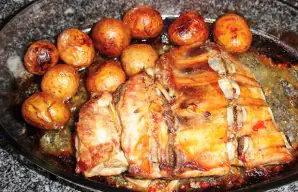Posted on Monday, January 2, 2017 in
Pork Recipes
Flavorful Crock Pot Bean Stew Recipe
Flavorful crock pot bean stew, it is made in some regions with red kidney beans, this dish is best served with white rice and crusty bread.
4 out of 5 with 33 ratings
Views: 42709
| Preparation time | n/a |
| Cooking Time | n/a |
| Ready In | 2 h 55 min |
| Level of Difficulty | Moderate |
| Servings | 4 |
Ingredients
1 large 6 quart crock pot1 lb baby back ribs (cut into small ribs)1 lb chourico sausage (cut into 1 inch slices)1 lb blood sausage (cut into pieces)1 lb presunto, smoked shoulder ham, or salted pork belly cut into 2 inch strips1 lb pig hocks or knuckles, pig ears etc.1 small regular cabbage, savoy cabbage or any green leafy cabbage (cut into quarters)2 carrots (sliced)1 large onion finely (chopped)2 large cloves garlic (chopped)1/4 cup of olive oil2 bay leaves1 teaspoon salt2 or 3 large 32 oz cans cooked kidney beans2 cups of chicken or vegetable broth1 medium ripe crushed tomato
Get Portuguese ingredients 
Preparation
- Day before salt the ribs and pig hocks or knuckles with 2 tablespoons of coarse salt. Leave overnight in the refrigerator to marinate. Note: You can leave the pork in salt for 3 days before cooking.
- When ready to cook saute the onions, garlic and bay leaf with olive oil in a heavy saucepan for about 3 minutes.
- Add the meats to the onion and brown on all sides.
- Turn crock pot on high. Begin layering; onion mix, the meats, carrots, ham.
- Add the cans of beans.
- Add the broth and tomato.
- Top with the cabbage.
- Be sure the lid covers the cabbage. Set the timer for 8 hours on high.
- After 4 hours stir gently and lower heat to low.
- After a few hours check the ribs and pork for doneness. The meat should fall off the bone but intact. The longer it cooks the more flavor it gets. You may need to cook the stew longer or it may be cooked depending on the heat of your crock pot.
- Serve with white rice.
Recipe & Photo Credit: Tia Maria's Blog, portuguesediner.com
Recommended Recipes
Heavenly Roasted Pork Spare Ribs Recipe
Serve these heavenly roasted pork spare ribs (costelas de porco assadas), with some roasted potatoes.
| Level of Difficulty | Very Easy |
| Servings | 4 |
Paula's Delicious Chouriço à Bras Recipe
Paula's delicious chouriço à bras recipe, is her own twist to the popular bacalhau à bras.
| Level of Difficulty | Easy |
| Servings | 4 |
Yum Roasted Pork Tenderloin Recipe
Yum roasted pork tenderloin recipe (receita de lombo de porco assado), pork loin seasoned, roasted until tender, served with flavorful sauce.
| Level of Difficulty | Easy |
| Servings | 3 |
Comments
There are no comments for this recipe.



